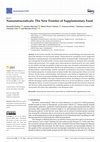Papers by Narimane Lammari

It is difficult to retard the release of highly water soluble drugs due to their fast dissolution... more It is difficult to retard the release of highly water soluble drugs due to their fast dissolution and absorption in gastro intestinal tract. A novel methylcellulose based elementary osmotic pump tablets of metoprolol succinate, which was used as a model drug, has been designed to overcome these drawbacks. Taguchi orthogonal L18 array design with analysis of variance was conducted to optimize the release profile. The results showed that the drug release was inversely proportional to the viscosity and amount of methylcellulose, thickness of semipermeable membrane and amount of dibutylphtalate, while it was directly proportional to the amount of polyethylene glycol 400 and independent to the compacting method and orifice size. The results approved also the reliability of this system to control the release of drug at zero order kinetic for up to 12 hours. The in vivo studies conducted in rabbits using the optimized and marketed formulations revealed that in addition to the enhanced bioa...

Nanomaterials
In the last few decades, the combination between nanotechnology and nutraceutics has gained the a... more In the last few decades, the combination between nanotechnology and nutraceutics has gained the attention of several research groups. Nutraceuticals are considered as active compounds, abundant in natural products, showing beneficial effects on human health. Unfortunately, the uses, and consequently the health benefits, of many nutraceutical products are limited by their unsuitable chemico-physical features. For example, many nutraceuticals are characterized by low water solubility, low stability and high susceptibility to light and oxygen, poor absorption and potential chemical modifications after their administration. Based on the potential efficacy of nutraceuticals and on their limiting features, nanotechnology could be considered a revolutionary innovation in empowering the beneficial properties of nutraceuticals on human health, thus enhancing their efficacy in several diseases. For this reason, nanotechnology could represent a new frontier in supplementary food. In this revie...

International Journal of Pharmaceutics
The last decade has witnessed a burgeoning global movement towards essential and vegetable oils i... more The last decade has witnessed a burgeoning global movement towards essential and vegetable oils in the food, agriculture, pharmaceutical, cosmetic, and textile industries thanks to their natural and safe status, broad acceptance by consumers, and versatile functional properties. However, efforts to develop new therapy or functional agents based on plant oils have met with challenges of limited stability and/or reduced efficacy. As a result, there has been increased research interest in the encapsulation of plant oils, whereby the nanocarriers serve as barrier between plant oils and the environment and control oil release leading to improved efficacy, reduced toxicity and enhanced patient compliance and convenience. In this review, special concern has been addressed to the encapsulation of essential and vegetable oils in three types of nanocarriers: polymeric nanoparticles, liposomes and solid lipid nanoparticles. First, the chemical composition of essential and vegetable oils was handled. Moreover, we gather together the research findings reported by the literature regarding the different techniques used to generate these nanocarriers with their significant findings. Finally, differences and similarities between these nanocarriers are discussed, along with current and future applications that are warranted by their structures and properties.

International Journal of Pharmaceutics
Plant-based remedies have been widely used for the management of variable diseases due to their s... more Plant-based remedies have been widely used for the management of variable diseases due to their safety and less side effects. In the present study, we investigated Saussurea lappa CB. Clarke. (SL) given its largely reported medicinal effects. Specifically, our objective was to provide an insight into a new polymethyl methacrylate based nanocapsules as carriers of SL essential oil and characterize their biologic functions. The nanoparticles were prepared by nanoprecipitation technique, characterized and analyzed for their cytotoxicity, anti-inflammatory, anti-Alzheimer and antidiabetic effects. The results revealed that the developed nanoparticles had a diameter around 145 nm, a polydispersity index of 0.18 and a zeta potential equal to +45 mV and they did not show any cytotoxicity at 25 μg·mL-1. The results also showed an anti-inflammatory activity (reduction in metalloprotease MMP-9 enzyme activity and RNA expression of inflammatory cytokines: TNF-α, GM-CSF and IL1β), a high anti-Alzheimer's effect (IC50 around 25.0 and 14.9 μg·mL-1 against acetylcholinesterase and butyrylcholinesterase, respectively), and a strong antidiabetic effect (IC50 were equal to 22.9 and 75.8 μg·mL-1 against α-amylase and α-glucosidase, respectively). Further studies are required including the in vivo studies (e.g., preclinical), the pharmacokinetic properties, the bioavailability and the underlying associated metabolic pathways.

Smart Nanocontainers
Abstract The last decade has witnessed an extensive use of biodegradable and biocompatible polyme... more Abstract The last decade has witnessed an extensive use of biodegradable and biocompatible polymers for biomedical applications. Concerning drug delivery the use of such polymers is of high importance among other types of polymers. The encapsulation of active molecules within a polymeric nanostructure yields many benefits such as enhanced drug bioavailability, sustained drug release, heightened drug efficiency, and a better control of drug targeting that by its turn are able to reduce the toxicity and side effects of the encapsulated molecule. In addition, encapsulation can protect the drug from natural barriers after administration, which permits a better control of the disease. In this work the preparation of polymeric nanocontainers was discussed, from the preparation methods used to their applications. Moreover, several methods for tweaking the particles were highlighted, the targeting strategies of the drug, and the effect of particles on the biodistribution was examined.

Biomacromolecules
Food waste valorization practices have gained considerable attention focusing on the conversion o... more Food waste valorization practices have gained considerable attention focusing on the conversion of the waste into valuable products. In this context, the present study provides an insight into a new Eudragit® RS 100 based nanosystem as a carrier of date palm (Phoenix dactylifera L.) seeds oil known for its an antidiabetic activity. A priori a systematic study was carried out in order to understand the individual impact of all contributing factors considered by the nanoprecipitation method. Then, date seeds oil nanoparticles were prepared, characterized and analyzed for their in vitro inhibition activity against: alpha amylase and alpha glucosidase. The results showed that the developed nanoparticles had an average diameter around 207 nm, a ζ-potential of +59 mV and encapsulation efficiency equal to 97 ±1% with a loading capacity of 0.48mg.mg-1. The alpha amylase and alpha glucosidase IC50 were found to be 87.6 and 155.3 µg.mL-1, respectively. Therefore, this study may surely open new perspectives for the development of novel health-promoting plant oils loaded-nanocarriers for several purposes.

Nanomedicine
Aim: To synthesize and examine the impact of free Eudragit® RS 100 nanoparticles (LN01), Quantum ... more Aim: To synthesize and examine the impact of free Eudragit® RS 100 nanoparticles (LN01), Quantum dots curcumin-loaded Eudragit RS 100 nanoparticles (LN04), and un-encapsulated curcumin nanoparticles (LN06) on cancerous and bacterial cells. Materials & methods: The LN01, LN04, LN06 were synthesized and characterized by Fourier transform infrared, ζ potential, UV–Vis spectroscopy, transmission electron microscopy and scanning electron microscopy and their biological activities were evaluated. Results: LN04 profoundly inhibited the growth of colon (HCT-116) cancerous cells (10.64% cell viability) and breast cancer (MCF-7) cells (10.32% cell viability) with compared to LN01 and LN06. Normal cells (HEK-293) did not show any inhibition after treatments. In addition, LN04 show better inhibitory action on bacterial growth compared with LN01 and LN06. Conclusion: We suggest that LN04 selectively target cancerous and bacterial cells and therefore possess potential anticancer and antibacterial...

It is difficult to retard the release of highly water soluble drugs due to their fast dissolution... more It is difficult to retard the release of highly water soluble drugs due to their fast dissolution and absorption in gastro intestinal tract. A novel methylcellulose based elementary osmotic pump tablets of metoprolol succinate, which was used as a model drug, has been designed to overcome these drawbacks. Taguchi orthogonal L18 array design with analysis of variance was conducted to optimize the release profile. The results showed that the drug release was inversely proportional to the viscosity and amount of methylcellulose, thickness of semipermeable membrane and amount of dibutylphtalate, while it was directly proportional to the amount of polyethylene glycol 400 and independent to the compacting method and orifice size. The results approved also the reliability of this system to control the release of drug at zero order kinetic for up to 12 hours. The in vivo studies conducted in rabbits using the optimized and marketed formulations revealed that in addition to the enhanced bioa...
Asian Journal of Pharmaceutical Sciences, 2014

Pharmaceutics
Essential oils are of paramount importance in pharmaceutical, cosmetic, agricultural, and food ar... more Essential oils are of paramount importance in pharmaceutical, cosmetic, agricultural, and food areas thanks to their crucial properties. However, stability and bioactivity determine the effectiveness of essential oils. Polymeric nanoencapsulation is a well-established approach for the preservation of essential oils. It offers a plethora of benefits, including improved water solubility, effective protection against degradation, prevention of volatile components evaporation and controlled and targeted release. Among the several techniques used for the design of polymeric nanoparticles, nanoprecipitation has attracted great attention. This review focuses on the most outstanding contributions of nanotechnology in essential oils encapsulation via nanoprecipitation method. We emphasize the chemical composition of essential oils, the principle of polymeric nanoparticle preparation, the physicochemical properties of essential oils loaded nanoparticles and their current applications.










Uploads
Papers by Narimane Lammari